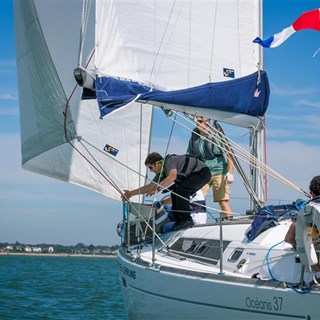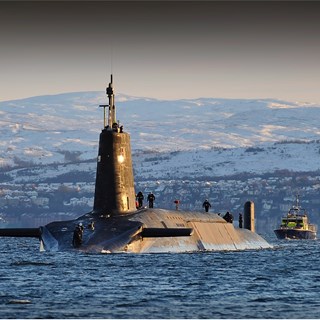
25 June 2025
As the maritime industry embraces the transformative potential of autonomy, developers face a unique challenge: how to innovate in a space where standards are still emerging, and trust in uncrewed systems is not yet fully established. At BMT, we believe simulation is a critical enabler in overcoming these hurdles—de-risking development, accelerating innovation, and building confidence across the entire lifecycle of autonomous systems.
Simulation, in its broadest sense, is the representation of real-world events or systems—whether through physics-based models or data-driven approaches. In the context of maritime autonomy, simulation allows us to explore, test, and refine complex systems in a controlled, repeatable, and cost-effective environment. It enables us to model everything from vessel behaviour in challenging sea states to the interaction between human operators and remote systems.
By integrating simulation into each phase of the systems development lifecycle—analysis, planning, design, development, testing, implementation, and maintenance—we can deliver safer, smarter, and more reliable autonomous solutions.

The earliest stages of system development are often the most critical. Simulation supports the definition of Concepts of Employment (CONEMP) and Use (CONUSE), helping stakeholders visualise how systems will operate in real-world scenarios.
Naval wargaming, for example, is a powerful technique that reduces complex operational scenarios into structured decision-making exercises. These simulations allow planners to test and refine strategies—such as the integration of crewed and uncrewed vessels in port environments—long before physical assets are deployed. This approach fosters innovation while ensuring that operational concepts are grounded in practical feasibility.

Simulation can play a pivotal role in the design and development phase, enabling rapid prototyping, immersive design validation, and collaborative system integration.
Virtual prototyping allows engineers to test concepts early, reducing the cost and risk of physical prototyping. For instance, remote operating centres—essential for overseeing uncrewed vessels—can be virtually modelled and iteratively refined to optimise human-machine interfaces.
Virtual reality (VR) further enhances this process by immersing stakeholders in simulated operational environments. Projects like the Ulstein Bridge Concept have demonstrated how VR can bring together designers, end-users, and human factors specialists to co-create effective solutions.
Co-simulation tools also allow for the integration of multiple subsystems into a unified virtual environment. This enables cross-disciplinary teams to identify interdependencies and resolve design conflicts early, without compromising sensitive information.
Moreover, simulation can generate synthetic data to support the development of AI-driven autonomy. By augmenting real-world datasets with simulated variations—such as different sea states or lighting conditions—developers can train more robust object detection models, improving system performance in diverse maritime environments.
[1] DOGA Ulstein Bridge Vision, https://doga.no/en/activities/design-og-innovasjon/design-driven-innovation-programme/dip-projects/maritim-og-offshore/ulstein-bridge-vision/
Testing autonomous systems in the real world is expensive, time-consuming, and often risky. Simulation offers a safer, more efficient alternative.
Virtual test environments (VTEs) allow engineers to replicate a wide range of operational scenarios, including rare or hazardous edge cases. These simulations can be repeated and adjusted with ease, enabling iterative refinement of control algorithms and system behaviours.
BMT’s own Maritime Autonomous Systems Synthetic Environment Assurance Service (MAS SEAS) trials[1], conducted within the REMBRANDT simulator[2], exemplify this approach. By simulating complex navigation scenarios governed by the International Regulations for Preventing Collisions COLREGs[3], we can assess an autonomous vessel’s decision-making capabilities under the scrutiny of qualified master mariners. This provides a robust evidence base for certification, helping to build trust with regulators and clients alike.
[1] BMT SEAS, https://www.bmt.org/innovations/bmt-seas
[2] BMT REMBRANDT, https://www.bmt.org/innovations/bmt-rembrandt/
[3] IMO COLREGS, https://www.imo.org/en/About/Conventions/Pages/COLREG.aspx

Once systems are deployed, simulation continues to add value—particularly in training and operational planning.
Virtual training environments allow operators to gain hands-on experience without putting assets at risk. This is especially important for remote operating centres, where even experienced mariners must adapt to new interfaces and workflows.
Augmented reality (AR) and immersive simulators further enhance training by replicating real-life scenarios, from tug operations to emergency evacuations. These tools support mission rehearsal, enabling crews to practise complex procedures—such as recovering uncrewed vessels to a mothership—under various conditions.
Digital twins, which mirror the real-time status of physical systems, provide an additional layer of situational awareness. By visualising vessel behaviour and environmental conditions based on real-time information from a vessel on the water, digital twins help operators make informed decisions, even when sensor data is limited or obscured.
In the maintenance phase, simulation supports predictive strategies that reduce downtime and extend asset life.
Machine learning algorithms can analyse sensor data to detect anomalies and forecast failures. By simulating fault progression, operators can schedule interventions before issues impact operations—an essential capability for uncrewed missions where on-the-fly repairs are not an option.
While simulation is not a panacea—it must be grounded in accurate data and validated through real-world trials—it offers three compelling advantages:
Embedding simulation throughout the development lifecycle will enable developers to innovate with confidence, accelerate time to market, and deliver autonomous systems that are safe, effective, and future-ready.

Will Roberts is a Maritime Autonomous Systems Engineer at BMT. He graduated from the University of Warwick with a Master’s degree in Systems Engineering before joining PINKERTON comprehensive risk management to work as a Security Program Agent.
Will joined BMT earlier this year as part of the Maritime Autonomy campaign team, applying his autonomy skills developed at Warwick.

N/A
In a world where complexity is the norm and certainty is rare, adaptability isn’t a luxury, it’s a necessity. And when we combine it with empathy, structure, and a commitment to quality, we create programmes that deliver real, lasting value.

N/A
In a world where complexity is the norm and certainty is rare, adaptability isn’t a luxury, it’s a necessity. And when we combine it with empathy, structure, and a commitment to quality, we create programmes that deliver real, lasting value.

Tim Curtis
Most transformation programmes fail—not because of poor execution, but because they never truly understood the race they were competing in. The BMT Strategy Canvas changes that.

N/A
Imagine gaining more space, deeper dives, faster refits, and safer missions—all by moving one critical system outside the pressure hull. Discover how pressure-tolerant lithium-sulphur batteries are transforming submarine design, and why this breakthrough isn’t just theoretical—it’s ready for deployment. Whether you're upgrading or designing new, this is capability you can deliver today.